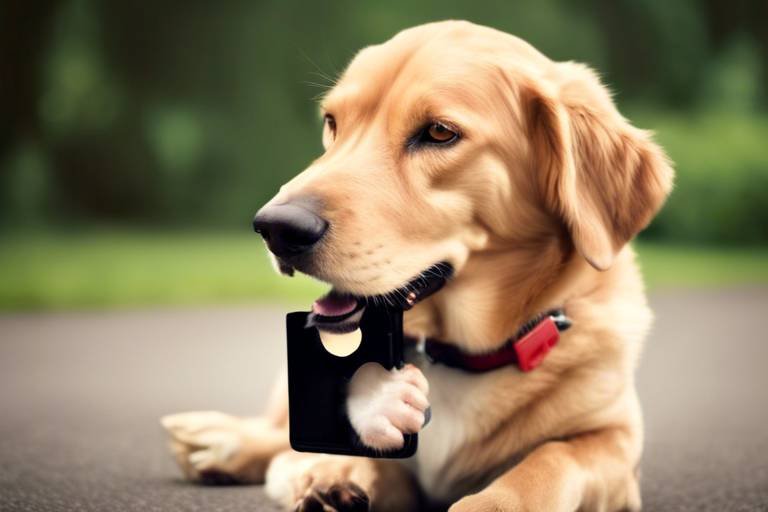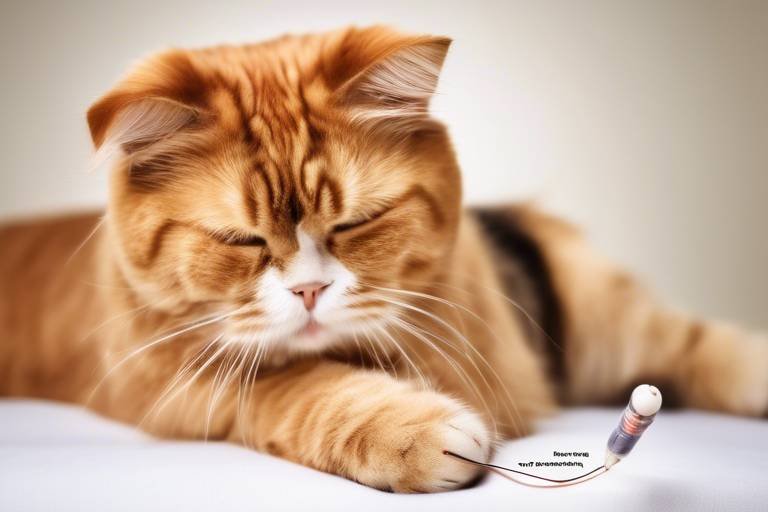Tips for Keeping Your Pet's Ears Clean and Healthy
Every pet owner knows that our furry friends deserve the best care possible, and that includes keeping their ears clean and healthy. Just like you wouldn't ignore a scratchy throat or a runny nose, your pet's ears also need some TLC! Regular ear maintenance can prevent infections and discomfort, ensuring that your pet remains happy and playful. But where do you start? Well, that's what we're here to explore! In this article, we'll dive into essential tips and insights on maintaining your pet's ear health, preventing infections, and ensuring their overall well-being through proper cleaning techniques and regular check-ups.
To effectively care for your pet's ears, it's crucial to understand their anatomy. Did you know that a dog's ear is made up of three parts: the outer ear, the middle ear, and the inner ear? The outer ear is what we can see, while the middle and inner parts are responsible for hearing and balance. Understanding this structure helps highlight areas that require attention and care. For instance, the ear canal in dogs and cats is much more vertical than in humans, which can trap moisture and debris, leading to potential issues. By knowing your pet's ear anatomy, you can better monitor and care for their ears, ensuring they stay clean and healthy.
Now that you've got a grasp on ear anatomy, let’s talk about common ear problems that can affect your beloved pets. Infections, mites, and wax buildup are just a few culprits that can cause discomfort. Recognizing these issues early on can save your pet from a lot of pain and you from hefty vet bills. Symptoms to watch for include excessive scratching, shaking of the head, or even a foul odor coming from the ears. If you notice any of these signs, it's essential to act quickly to address these problems before they escalate.
So, how do you know if your pet has an ear infection? Look out for signs like an unpleasant odor, redness or swelling in the ear canal, and your pet's tendency to scratch or rub their ears against surfaces. These symptoms can lead to more severe complications if left untreated. Think of it like a small fire; if you catch it early, you can extinguish it before it spreads. Prompt action can prevent more severe complications and discomfort for your pet, so stay vigilant!
Incorporating routine ear checks into your pet's grooming schedule is vital for early detection of problems. Just as you would regularly check your own health, your pet's ear health deserves the same attention. A quick weekly inspection can help you spot any unusual signs before they turn into significant issues. Make it a habit to gently lift your pet's ears and check for any debris, redness, or foul smells. This simple practice can go a long way in maintaining their ear health.
Knowing when to seek professional help is essential for your pet's well-being. If you notice persistent signs of discomfort, such as excessive scratching or an unusual discharge, it's time to consult a vet. Don't wait until the issue worsens; your vet can provide the necessary treatment and guidance to ensure your pet's ears are in tip-top shape. Remember, it's always better to be safe than sorry!
Learning the proper ear cleaning techniques can prevent buildup and infections. Begin by gathering your supplies: a gentle ear cleaning solution, cotton balls, and treats to reward your pet for being a good boy or girl during the process! Start by gently lifting your pet's ear flap and applying a few drops of the cleaning solution into the ear canal. Massage the base of the ear for about 30 seconds to help loosen debris, then let your pet shake their head to expel the solution. Finally, use a cotton ball to wipe away any excess fluid and debris. It's a simple process that can make a world of difference!
Selecting appropriate ear cleaning solutions is crucial for your pet's safety. Not all products are created equal, and some can be too harsh for your furry friend's sensitive ears. Look for solutions specifically designed for pets, which are typically pH balanced and free from alcohol or harsh chemicals. Always read the labels carefully to ensure you're using a product that is safe and effective for your pet's specific needs.
When it comes to ear cleaning solutions, you might wonder whether to go homemade or commercial. Both have their pros and cons:
- Homemade Solutions: Often cost-effective and can be made with natural ingredients, but may lack the effectiveness of commercial products.
- Commercial Solutions: Specifically formulated for pets, ensuring safety and effectiveness, but can be pricier.
Ultimately, the choice depends on your pet's specific needs and your comfort level with DIY solutions. Just remember to consult your vet before trying anything new!
Creating a regular ear cleaning schedule helps maintain your pet's ear health. Aim for a cleaning session every few weeks, or more frequently if your pet is prone to ear issues. Incorporate this into your pet's grooming routine, so it becomes second nature for both you and your furry friend. Consistency is key when it comes to ear care, and your pet will thank you for it!
Q: How often should I clean my pet's ears?
A: It depends on your pet's breed and ear health. Generally, cleaning every few weeks is advisable, but consult your vet for personalized recommendations.
Q: Can I use human ear cleaning products on my pet?
A: No, human products can be too harsh for pets. Always use products specifically designed for animals.
Q: What should I do if I notice a bad odor from my pet's ears?
A: A bad odor may indicate an infection or wax buildup. It's best to consult your veterinarian for proper diagnosis and treatment.

Understanding Ear Anatomy
Understanding your pet's ear anatomy is crucial for maintaining their ear health. Just like humans, pets have a complex ear structure that plays a vital role in their overall well-being. The ear is divided into three main parts: the outer ear, the middle ear, and the inner ear. Each segment has its own function and requires specific care.
The outer ear consists of the visible part, known as the pinna, which helps capture sound waves and direct them into the ear canal. This canal is lined with skin that produces wax, which serves as a natural defense mechanism against dust, dirt, and microorganisms. However, excessive wax buildup can lead to problems, making it essential to monitor this area regularly.
Moving deeper, we have the middle ear, which is separated from the outer ear by the eardrum. This area is crucial for transmitting sound vibrations to the inner ear. If fluid accumulates here, it can cause infections and discomfort. Lastly, the inner ear is responsible for both hearing and balance. It houses the cochlea, which converts sound vibrations into nerve signals that the brain interprets as sound. Any issues in this area can significantly affect your pet's quality of life.
To help you better understand the anatomy of your pet's ears, here’s a simple diagram:
| Part of the Ear | Function |
|---|---|
| Outer Ear | Catches sound waves and protects the ear canal |
| Middle Ear | Transmits sound vibrations to the inner ear and regulates pressure |
| Inner Ear | Converts sound vibrations to nerve signals and maintains balance |
By understanding these components, you can better appreciate the importance of regular ear cleaning and monitoring. Just like a well-oiled machine, if one part of your pet's ear isn't functioning correctly, it can lead to a cascade of problems. So, keep an eye on those floppy ears and ensure they are in tip-top shape!

Common Ear Problems
When it comes to our furry friends, ear health is often overlooked, yet it plays a crucial role in their overall well-being. Just like humans, pets can suffer from a variety of ear issues that can cause discomfort and even lead to serious health problems if not addressed promptly. Among the most common ear problems are infections, ear mites, and allergic reactions. Understanding these issues can empower you as a pet owner to take action before things escalate.
Ear infections, for instance, are a frequent concern, especially in breeds with floppy ears like Cocker Spaniels or Basset Hounds. These breeds are particularly prone to moisture buildup, which creates a perfect breeding ground for bacteria and yeast. Symptoms of an ear infection can include redness, swelling, and a discharge that may have a foul odor. If you notice your pet shaking their head more than usual or scratching at their ears, it’s a sign that something might be wrong. In some cases, the infection can become severe, leading to pain and even hearing loss if left untreated.
Another common issue is the presence of ear mites, which are microscopic parasites that can cause intense itching and discomfort. These little critters are highly contagious and can easily spread from one pet to another. Signs of ear mites include dark, coffee-ground-like debris in the ear and excessive scratching. If you suspect your pet has ear mites, it’s essential to consult your veterinarian for an accurate diagnosis and treatment.
Additionally, allergic reactions can manifest in various ways, including ear problems. Pets can be allergic to food, pollen, dust, or even certain chemicals in grooming products. Allergies can lead to inflammation in the ear canals, making them more susceptible to infections. If you notice your pet's ears are red and inflamed, or if they are constantly scratching at them, it may be time to investigate potential allergens.
To help you better understand these common ear problems, here’s a quick summary of symptoms and issues to watch for:
| Ear Problem | Symptoms | Recommended Action |
|---|---|---|
| Ear Infections | Redness, swelling, discharge, foul odor | Consult a vet for treatment |
| Ear Mites | Dark debris, scratching, shaking head | Veterinary examination and medication |
| Allergic Reactions | Redness, inflammation, scratching | Identify allergens and consult a vet |
Being proactive about your pet's ear health can save you a lot of trouble down the road. Regular checks combined with a keen eye for any unusual behavior can help catch these problems early. Remember, your pet relies on you to keep them healthy and happy, and that includes their ears!
Signs of Ear Infections
Ear infections in pets can be a silent menace, creeping up on your furry friend without much warning. It's essential to be vigilant and recognize the signs that indicate your pet might be suffering from an ear infection. One of the most noticeable symptoms is a foul odor emanating from the ear. If you catch a whiff of something unpleasant, it's time to take a closer look. Additionally, you might observe your pet shaking their head more frequently than usual or scratching at their ears incessantly, which can indicate discomfort.
Another red flag is the presence of discharge from the ear. This could range from a clear fluid to a dark, waxy substance, and it’s crucial to take note of the color and consistency, as it can provide valuable information to your veterinarian. You may also notice your pet being more irritable or lethargic than usual, which can be a direct result of the pain associated with an ear infection.
In some cases, you might see your pet tilting their head to one side. This behavior can be a sign that they are trying to alleviate discomfort or that they are experiencing balance issues due to the infection. If you observe any of these symptoms, it’s essential to act promptly. A quick trip to the vet can help diagnose the issue and prevent it from escalating into something more serious.
To help you better understand the signs of ear infections, here’s a quick summary:
- Foul odor from the ear
- Excessive head shaking
- Frequent scratching at the ears
- Discharge from the ear
- Increased irritability or lethargy
- Head tilting
Being observant and proactive can make all the difference in your pet's ear health. Regularly checking your pet’s ears and noting any changes can help catch infections early, ensuring they receive the care they need before the situation worsens.
Q: How often should I check my pet's ears?
A: It's a good practice to check your pet's ears at least once a week. Regular checks can help you catch any issues before they escalate.
Q: Can I use human ear cleaning products on my pet?
A: No, you should avoid using human products as they can be harmful to pets. Always opt for products specifically designed for animal use.
Q: What should I do if I notice signs of an ear infection?
A: If you notice any signs of an ear infection, such as odor or discharge, consult your veterinarian as soon as possible for a proper diagnosis and treatment plan.
Importance of Regular Checks
When it comes to keeping your furry friend healthy, regular ear checks should be at the top of your list. Just like we schedule routine check-ups with our doctors, our pets need the same kind of attention, especially when it comes to their ears. These checks are not only about cleaning; they are a proactive measure to catch any potential issues before they escalate into something serious. Think of it as a preventative maintenance plan for your pet's overall health!
During these checks, you should look for any signs of discomfort or unusual behavior. For instance, if your pet is frequently shaking their head, scratching at their ears, or seems to be in pain when you touch their head, it could be a red flag. Regularly checking your pet's ears can help you spot issues like ear infections, wax buildup, or even pesky ear mites. The earlier you identify these problems, the easier they are to treat, and the less discomfort your pet will experience.
To make these regular checks easier, consider incorporating them into your pet's grooming routine. You might schedule a specific day each week to check their ears, or simply make it part of your playtime. This not only helps you stay on top of their ear health but also helps your pet get used to having their ears handled. Remember, a little bit of routine can go a long way in preventing larger health problems down the line!
Moreover, if you notice any of the following symptoms during your checks, it’s crucial to consult a veterinarian:
- Foul odor coming from the ear
- Redness or swelling in the ear canal
- Excessive wax or discharge
- Changes in behavior such as increased irritability or lethargy
In summary, regular ear checks are an essential part of your pet's health care routine. They help ensure that your pet remains comfortable and free from infections or other complications. By being vigilant and proactive, you can contribute significantly to your pet's quality of life. After all, a happy pet is a healthy pet!
When to Consult a Vet
Knowing when to consult a veterinarian regarding your pet's ear health is crucial for their overall well-being. While regular home checks and cleaning can help maintain your pet's ears, there are specific signs and symptoms that should prompt immediate professional attention. For instance, if you notice your pet shaking their head excessively or scratching at their ears more than usual, it could be a sign of discomfort or an underlying issue. Additionally, unpleasant odors emanating from the ears, or any visible discharge, can indicate an infection that requires medical intervention.
Another red flag is if your pet exhibits signs of pain when you touch their ears. This could manifest as yelping, biting, or pulling away when you attempt to examine them. If you observe any of these behaviors, it’s essential to consult with a veterinarian as soon as possible. Furthermore, if your pet's ears appear red, swollen, or have a crusty appearance, these are also indicators that something may be amiss.
In some cases, ear mites can be a significant issue, especially in cats and dogs that spend time outdoors or interact with other animals. If you suspect ear mites, look for symptoms like dark, coffee-ground-like debris in the ear canal. This may require a vet's diagnosis and treatment. Early intervention is key, as untreated ear issues can lead to more severe complications, including chronic infections and even hearing loss.
In summary, here are some key signs that should prompt you to seek veterinary help:
- Excessive head shaking or scratching at the ears
- Unpleasant odors or discharge from the ears
- Visible redness, swelling, or crustiness
- Pain or discomfort when touching the ears
- Presence of dark debris or signs of ear mites
By being attentive to these warning signs and consulting with your vet when necessary, you can help ensure that your furry friend maintains healthy ears and a happy life. Remember, your veterinarian is your best resource in keeping your pet's ears in top shape!
Q: How often should I check my pet's ears?
A: It's a good practice to check your pet's ears at least once a week, especially if they are prone to ear issues. Regular checks can help catch problems early.
Q: Can I use human ear cleaning products on my pet?
A: No, it's not recommended. Human ear cleaning products can contain ingredients that may be harmful to pets. Always use products specifically designed for pets.
Q: What should I do if I notice something unusual in my pet's ears?
A: If you notice any unusual signs such as odor, discharge, or discomfort, consult your veterinarian for a proper diagnosis and treatment plan.
Q: How can I prevent ear infections in my pet?
A: Regular cleaning, keeping the ears dry, and monitoring for allergies or skin issues can help prevent ear infections. If your pet is prone to infections, your vet may recommend a specific cleaning routine.
Effective Cleaning Techniques
Keeping your pet's ears clean is not just about aesthetics; it’s about their overall health and comfort. Regular cleaning can prevent infections and other ear-related issues that may arise. So, how do you effectively clean your furry friend's ears? First off, it’s essential to gather the right supplies before diving into the cleaning process. You’ll need some cotton balls or pads, a gentle ear cleaning solution specifically designed for pets, and perhaps a towel to catch any mess. Now, let’s break down the steps to ensure you do this safely and effectively.
Start by creating a calm environment. Your pet may feel anxious about having their ears handled, so it’s crucial to make the experience as stress-free as possible. Consider giving them a treat before you begin to create a positive association with ear cleaning. Once your pet is comfortable, gently hold their head still and apply a few drops of the ear cleaning solution into the ear canal. Make sure to follow the instructions on the product label for the correct amount.
After applying the solution, massage the base of the ear for about 20 to 30 seconds. This step is vital as it helps to loosen any wax or debris that may be stuck inside. You might hear some funny sounds as the solution works its magic—don’t be alarmed! It’s just the solution doing its job. Following the massage, allow your pet to shake their head. This natural reaction helps to dislodge any remaining debris, and it’s quite entertaining to watch!
Next, take a cotton ball or pad and gently wipe the visible parts of the ear. Be careful not to insert anything deep into the ear canal, as this can cause injury. Focus on cleaning the outer ear, removing any wax or dirt you can see. If you notice any excessive wax buildup or a foul smell, this could indicate an underlying issue, and you should consult your veterinarian.
It’s also worth noting that some pets may require more frequent cleaning than others. For example, breeds with floppy ears, like Cocker Spaniels or Basset Hounds, are more prone to ear infections due to moisture retention. In such cases, you might want to establish a more regular cleaning schedule. On the other hand, pets with upright ears may need less frequent attention. Regardless of your pet's breed, always monitor their ears for any signs of discomfort or infection.
To help you remember these essential steps, here’s a quick summary:
- Gather your supplies: ear cleaner, cotton balls, and a towel.
- Calm your pet and create a positive atmosphere.
- Apply the ear cleaning solution and massage the base of the ear.
- Let your pet shake their head to dislodge debris.
- Wipe the outer ear with a cotton ball, avoiding deep insertion.
- Monitor for any signs of infection or discomfort.
By following these effective cleaning techniques, you can help ensure your pet's ears stay healthy and free of infections. Remember, a little bit of care goes a long way in maintaining your furry friend's well-being!
Q: How often should I clean my pet's ears?
A: It depends on the breed and individual needs of your pet. Generally, once a month is a good starting point, but some breeds may require more frequent cleaning.
Q: What should I do if I notice a bad smell coming from my pet's ears?
A: A bad smell can indicate an infection or other issues. It's best to consult your veterinarian for a proper diagnosis and treatment.
Q: Can I use human ear cleaning products on my pet?
A: No, human products can be too harsh for pets. Always use cleaning solutions specifically formulated for animals.
Q: Is it normal for my pet to shake their head after cleaning?
A: Yes, shaking their head is a natural response to dislodge any excess cleaning solution and debris.

Choosing the Right Cleaning Products
When it comes to your pet’s ear health, selecting the right cleaning products is absolutely vital. Just like you wouldn’t use just any soap on your skin, the same principle applies to your furry friend’s ears. The ear canal is sensitive and can easily be irritated by harsh chemicals or unsuitable ingredients. Therefore, it’s essential to choose products that are specifically formulated for pets and are gentle yet effective.
First off, let’s talk about what to look for in ear cleaning solutions. You want to ensure that the product is alcohol-free and free from any strong fragrances. Alcohol can dry out the delicate skin inside your pet's ears, leading to discomfort and potentially worsening any existing issues. Instead, opt for solutions that contain soothing ingredients like aloe vera or witch hazel, which can help calm any irritation.
Additionally, it's important to consider whether the product is designed for your specific type of pet. For instance, the ear cleaning needs of a dog can differ dramatically from those of a cat. Some cleaning solutions are formulated to target specific issues, such as wax buildup or ear mites, so make sure to read the labels carefully. Always consult your veterinarian if you’re unsure which product would be best for your pet.
Here’s a quick comparison table to help you understand different types of ear cleaning products:
| Product Type | Pros | Cons |
|---|---|---|
| Commercial Solutions | Specifically formulated, often effective against ear issues | Can be more expensive |
| Homemade Solutions | Cost-effective, can be made with natural ingredients | May not be as effective, risk of improper formulation |
Now, let’s dive into the debate of homemade versus commercial solutions. Homemade solutions can be a great option if you prefer natural ingredients and have a bit of DIY spirit. For example, a mix of equal parts of apple cider vinegar and water can help maintain a healthy pH level in your pet’s ears. However, it’s crucial to ensure that the solution is safe for your specific pet and doesn’t cause any adverse reactions. Always perform a patch test before widespread use.
On the other hand, commercial ear cleaning products are often tested for safety and efficacy, giving pet owners peace of mind. These solutions usually come with clear instructions and are tailored to address specific ear issues, which can simplify the cleaning process. They may also contain additional ingredients that help prevent infections and soothe irritation.
In conclusion, choosing the right cleaning product is a significant step towards maintaining your pet’s ear health. Whether you go for a commercial solution or a homemade alternative, always prioritize safety and effectiveness. Regular ear cleaning can prevent many common issues, so make this a part of your pet care routine. And remember, when in doubt, consult with your vet to ensure you’re making the best choice for your furry friend!
- How often should I clean my pet's ears? It typically depends on the breed and ear type, but a general guideline is once every 1-2 weeks.
- Can I use human ear cleaning solutions on my pet? No, human products can be too harsh and may cause irritation or damage.
- What should I do if my pet resists ear cleaning? Try to make the process more comfortable by using treats and gentle handling, or consult a vet for advice.
Homemade vs. Commercial Solutions
When it comes to keeping your furry friend's ears clean, you might find yourself at a crossroads: should you opt for homemade solutions or go with commercial products? Each option has its own set of benefits and drawbacks, and understanding them can help you make the best choice for your pet's ear health.
First off, let's talk about homemade solutions. Many pet owners love the idea of making their own ear cleaning solution because it allows for complete control over the ingredients. Common recipes often include simple items like white vinegar, water, and sometimes a few drops of essential oils. These natural ingredients can be effective in removing wax buildup and preventing odors. However, it's crucial to ensure that the ingredients you choose are safe for your pet. For example, some essential oils can be toxic to animals, so always do your research or consult your vet.
On the flip side, commercial ear cleaning products are specifically formulated for pets and typically undergo rigorous testing to ensure safety and effectiveness. These products often contain antibacterial and antifungal agents that can help combat infections and soothe irritation. They come in various forms, such as drops or wipes, making them convenient for pet owners who may not have the time or resources to create homemade solutions. However, they can be pricier than DIY options, and some may contain chemicals that could irritate sensitive ears.
To help you decide, here’s a quick comparison in table format:
| Criteria | Homemade Solutions | Commercial Solutions |
|---|---|---|
| Cost | Generally cheaper | Can be more expensive |
| Ingredients | Natural, customizable | Formulated with specific agents |
| Effectiveness | Varies based on recipe | Consistent and reliable |
| Safety | Depends on chosen ingredients | Tested for pet safety |
| Convenience | Requires preparation | Ready to use |
Ultimately, the choice between homemade and commercial solutions depends on your pet's specific needs and your personal preferences. If you enjoy DIY projects and know what works best for your pet, homemade solutions can be a fantastic and cost-effective option. However, if you prefer the ease of use and guaranteed safety of commercial products, they can be a reliable choice for maintaining your pet's ear health.
- How often should I clean my pet's ears? It depends on your pet's breed and ear type, but generally, once every month is a good rule of thumb.
- Can I use human ear cleaning products on my pet? No, human products may contain ingredients that can be harmful to pets. Always use products specifically designed for animals.
- What should I do if my pet shows signs of discomfort during cleaning? Stop immediately and consult your veterinarian to rule out any underlying issues.

Establishing a Routine
Creating a regular ear cleaning schedule is not just a good idea; it's essential for maintaining your pet's ear health. Think of it like brushing your teeth; if you skip it, problems can arise. Just as we wouldn't want to deal with cavities, our furry friends deserve the same level of care when it comes to their ears. Establishing a routine not only helps prevent ear infections but also allows you to monitor for any unusual changes that might indicate a problem.
To get started, consider incorporating ear cleaning into your pet's regular grooming routine. This could be done weekly or bi-weekly, depending on your pet's breed and lifestyle. For instance, dogs with floppy ears or those who love swimming may require more frequent cleaning compared to those with upright ears. It's also a good idea to pair ear cleaning with another grooming activity, such as bathing or brushing, to make it a seamless part of your pet's care.
When you set a schedule, consistency is key. Just like humans thrive on routine, pets do too. If your pet knows that ear cleaning happens every Saturday morning, they may become more accustomed to the process and less anxious about it. You might even reward them with a treat afterward to create a positive association with the activity. After all, who doesn't love a little pampering?
In addition to cleaning, regular checks of your pet's ears during grooming sessions can help you spot issues early. Look for signs such as redness, swelling, or unusual discharge. If you notice anything concerning, it’s best to consult your veterinarian. By incorporating these checks into your routine, you're not just cleaning; you're actively participating in your pet's health care.
Here’s a simple table to illustrate a potential ear cleaning schedule:
| Pet Type | Ear Cleaning Frequency | Notes |
|---|---|---|
| Dogs (Floppy Ears) | Weekly | More prone to infections; keep an eye out for moisture. |
| Dogs (Upright Ears) | Bi-weekly | Less prone to infections but still need regular checks. |
| Cats | Monthly | Regular checks are essential; many cats keep their ears clean. |
Ultimately, establishing a routine for ear care is about creating a bond with your pet while ensuring their health. By taking the time to incorporate ear cleaning into your schedule, you're not only helping to prevent potential issues but also showing your furry friend that you care. So grab those cleaning supplies, set a date, and make it a regular part of your pet care routine. Your pet will thank you for it!
Q: How often should I clean my pet's ears?
A: It depends on the breed and lifestyle of your pet. Generally, dogs with floppy ears may need weekly cleaning, while those with upright ears can go bi-weekly. Cats typically need less frequent cleaning.
Q: What are the signs that my pet might have an ear infection?
A: Look for symptoms such as excessive scratching, odor, redness, swelling, or discharge from the ears.
Q: Can I use human ear cleaning products on my pet?
A: No, it's best to use products specifically designed for pets, as human products can be harmful to them.
Q: How can I make ear cleaning easier for my pet?
A: Establish a routine, use treats as rewards, and ensure a calm environment to help your pet feel more comfortable during the process.
Frequently Asked Questions
- How often should I clean my pet's ears?
It's generally recommended to check and clean your pet's ears every 1 to 4 weeks, depending on their breed and ear type. Dogs with floppy ears may need more frequent cleaning compared to those with upright ears. Regular checks can help you catch any issues before they become serious.
- What are the signs that my pet may have an ear infection?
Watch for symptoms like excessive scratching, shaking their head, a foul odor, redness, swelling, or discharge from the ear. If you notice any of these signs, it’s best to consult your vet to prevent further complications.
- Can I use human ear cleaning solutions on my pet?
No, it's not advisable to use human ear cleaning solutions on pets. Their ear chemistry is different, and using the wrong products can cause irritation or harm. Always opt for products specifically designed for pets.
- What should I do if my pet resists ear cleaning?
If your pet is anxious or resistant, try to make the experience more comfortable. Use treats and praise to create a positive association. You can also start slowly, letting them sniff the cleaning solution before using it. If they continue to resist, consider consulting a vet for advice.
- Are homemade ear cleaning solutions effective?
Homemade solutions can be effective, but it’s crucial to use safe ingredients. A common mixture is equal parts vinegar and water, which can help with mild cleaning. However, if your pet has a serious issue, it’s best to use commercial products or consult your vet.
- When should I take my pet to the vet for ear issues?
If you notice persistent symptoms like discharge, odor, or discomfort despite cleaning, or if your pet is in pain, it’s time to see a vet. Early intervention can prevent more severe problems and ensure your pet stays healthy.



















